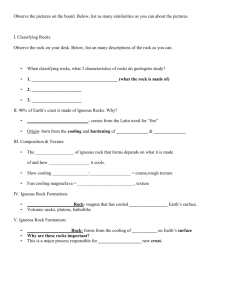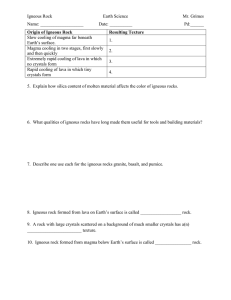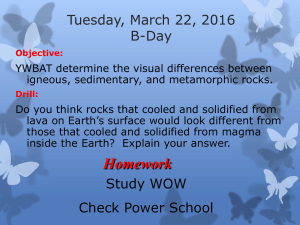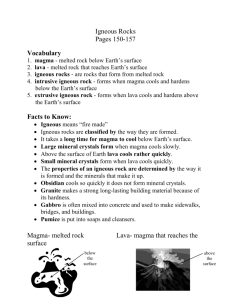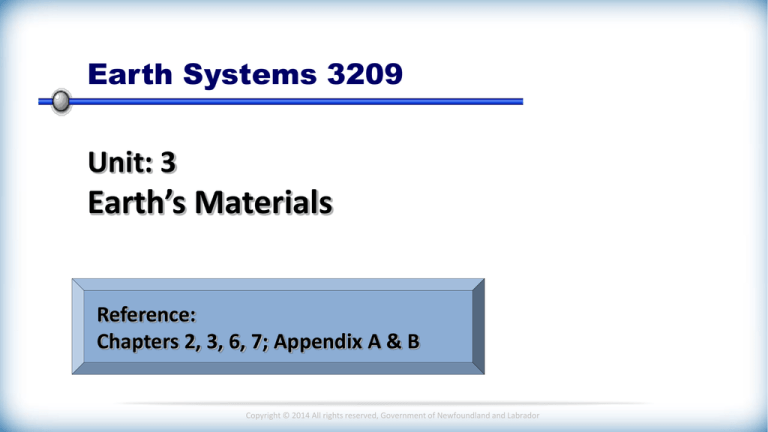
Earth Systems 3209
Unit: 3
Earth’s Materials
Reference:
Chapters 2, 3, 6, 7; Appendix A & B
Copyright © 2014 All rights reserved, Government of Newfoundland and Labrador
Unit 3:
Topic 3.1
Igneous Rocks (Overview)
Focus on . . .
describing the terminology associated with Igneous
rocks.
Relating composition, parent rock, texture, and
environment to the classification of igneous rocks.
Copyright © 2014 All rights reserved, Government of Newfoundland and Labrador
Difference Between a Rock and a Mineral
Rock
A rock is a consolidated mixture of one or more minerals.
Ex. Granite and Basalt.
In some cases a pure mineral may also be classified as a rock.
Mineral
A mineral must satisfy the following conditions;
1) Occur in nature
4) Definite chemical composition
2) Inorganic
5) Definite molecular structure
3) Solid
Copyright © 2014 All rights reserved, Government of Newfoundland and Labrador
Rock Forming Minerals
The rock cycle suggest that ALL rock types originally
started as igneous rock (solidified magma).
Igneous rocks form from Eight minerals called the
rock forming minerals.
1) Olivine
5) Plagioclase Feldspar
2) Pyroxene
6) Orthoclase Feldspar
3) Amphibole
7) Muscovite Mica
4) Biotite Mica
8) Quartz
Copyright © 2014 All rights reserved, Government of Newfoundland and Labrador
Magma and Lava
Molten rock in the Earth is called magma.
Magma is buoyant, rises to surface, &
sometimes breaks through and flows onto
Earth’s surface.
When magma reaches Earth’s surface it is
called lava.
Copyright © 2014 All rights reserved, Government of Newfoundland and Labrador
Magma and Lava
As magma cools, atoms arrange in an orderly crystal
structure, this is known as Crystallization.
Note: the different crystal Sizes.
Coarse-grained igneous rock
Copyright © 2014 All rights reserved, Government of Newfoundland and Labrador
Magma and Lava
Crystal size will depend on;
1) Rate of cooling and 2) Cooling environment
Coarse (larger) crystals
- slow cooling rate and form inside of Earth (Plutonic)
Fine (smaller) crystals
- fast cooling rate and form on Earth’s surface (Volcanic)
Copyright © 2014 All rights reserved, Government of Newfoundland and Labrador
Classifying Igneous Rocks
An igneous rock is formed when magma or lava
cools and solidifies.
Igneous rocks are classified according to;
1) Texture
-- Describes the appearance of an igneous rock, based
on the size, shape and arrangement of interlocking
crystals.
-- Depends on; how fast or slow the magma/lava cools.
2) Mineral Composition
-- Is the mineral makeup of an igneous rock based on
the chemical composition of the parent magma.
Copyright © 2014 All rights reserved, Government of Newfoundland and Labrador
Text
Reference
pages 61 - 65
Texture depends on Cooling Environment:
1) Volcanic (Extrusive) Environment:
Igneous rocks that form at the surface.
Fine crystals form on or near Earth’s surface
where lava cools quickly in the matter of
minutes to hours.
Therefore, the quicker the molten rock cools,
the smaller the crystals.
Copyright © 2014 All rights reserved, Government of Newfoundland and Labrador
Lava
Cools
Quickly
Fine Texture
Texture depends on Cooling Environment:
2) Plutonic (Intrusive) Environment
Igneous rocks that form beneath Earth’s
surface.
Magma
Cools
Slowly
Large crystals form deep within Earth
where magmas may take up to tens of
thousands of years to cool and crystallize.
Coarse Texture
Therefore, the slower the molten rock
cools, the larger the crystals.
Copyright © 2014 All rights reserved, Government of Newfoundland and Labrador
Texture depends on Cooling Environment:
Plutonic rocks
To see them, they must be uplifted to surface
and softer surrounding rock eroded away.
Magma Body
Copyright © 2014 All rights reserved, Government of Newfoundland and Labrador
Texture depends on Cooling Environment:
Plutonic rocks
To see them, they must be uplifted to surface
and softer surrounding rock eroded away.
Copyright © 2014 All rights reserved, Government of Newfoundland and Labrador
Texture depends on Cooling Environment:
Plutonic igneous rock
example:
El Capitan
Yosemite National Park,
California
Copyright © 2014 All rights reserved, Government of Newfoundland and Labrador
Composition depends on Parent Material:
Depends on the chemical makeup of the parent magma.
Often classified as either Mafic or Felsic composition.
Mafic Composition:
are generally dark in colour since they are comprised of mostly darkcoloured minerals. Examples of dark-coloured minerals include:
olivine; hornblende; and pyroxene.
Felsic Composition:
are generally light in colour since they are comprised of mostly light
coloured minerals. Examples of light-coloured minerals include:
quartz; orthoclase feldspar; and muscovite mica.
Copyright © 2014 All rights reserved, Government of Newfoundland and Labrador
Composition depends on Parent Material:
Magma
cools and crystallize
solidifies
forms silicate minerals
Two major silicate mineral groups:
DARK silicates
LIGHT silicates
Copyright © 2014 All rights reserved, Government of Newfoundland and Labrador
Composition depends on Parent Material:
Silicate group
DARK
Rich in
Fe and/or Mg
Poor in
Si
Examples
olivine
pyroxene
amphibole
biotite
LIGHT
Si, K, Na, Ca
Fe and/or Mg
quartz
muscovite
feldspars
orthoclase
Copyright © 2014 All rights reserved, Government of Newfoundland and Labrador
plagioclase
Composition depends on Parent Material:
Igneous rocks compositions
mafic
magnesium + ferrum
High in Mg and Fe.
Dark and Dense
Found in Ocean Crust
felsic
feldspar + silica (quartz)
High in Si.
Lighter and Less Dense
Found in Continental Crust
Copyright © 2014 All rights reserved, Government of Newfoundland and Labrador
Example 1:
What is the origin of fine-grained igneous rock?
(A) lava that cooled quickly on Earth’s surface
(B) lava that cooled slowly on Earth’s surface
(C) silt that settled quickly in ocean water
(D) silt that settled slowly in ocean water
Which describes the cooling rate and crystal size of magma
that cools deep beneath Earth’s surface?
Cooling Rate
Crystal Size
(A)
fast
large
(B)
fast
small
(C)
slow
large
(D)
slow
small
Copyright © 2014 All rights reserved, Government of Newfoundland and Labrador
Example 2:
Which rock type will form at location “Z” in the diagram below?
(A)
(B)
(C)
(D)
chemical sedimentary
clastic sedimentary
extrusive igneous
intrusive igneous
Sea Level
Z
Oceanic Crust
Continental Crust
Copyright © 2014 All rights reserved, Government of Newfoundland and Labrador
Your Turn . . .
Take the time and complete the following questions . . .
(Solutions to follow)
Question:
Briefly describe how a geologist would
use texture and mineral composition to
determine the type of igneous rock.
Copyright © 2014 All rights reserved, Government of Newfoundland and Labrador
Solutions . . .
Question:
Igneous rocks can be classified according to its texture and composition.
Texture refers to the size, shape, and arrangement of minerals within an
igneous rock and is determined by the environment and the rate at which
the molten rock cools. The faster the cooling, the smaller the crystals.
This can form a glassy or fine (aphanitic) texture. The slower the cooling
rate, the larger the crystals. This can form a coarse (phaneritic) texture.
Composition refers to the mineral make up of the igneous rock. Minerals
in igneous rocks are generally dark in color or light in color. Igneous
rocks are classified as mafic, intermediate and felsic. Each of these three
classifications are based on the mineral composition and are reflected by
the relative color of the igneous rock.
Copyright © 2014 All rights reserved, Government of Newfoundland and Labrador
Summary . . .
Overview of Points covered:
Igneous Rocks;
Form from Magma or Lava.
Form in Plutonic (Intrusive) or Volcanic (Extrusive)
Environments.
Are generally Dark (Mafic) or Light (Felsic) in color.
Copyright © 2014 All rights reserved, Government of Newfoundland and Labrador


